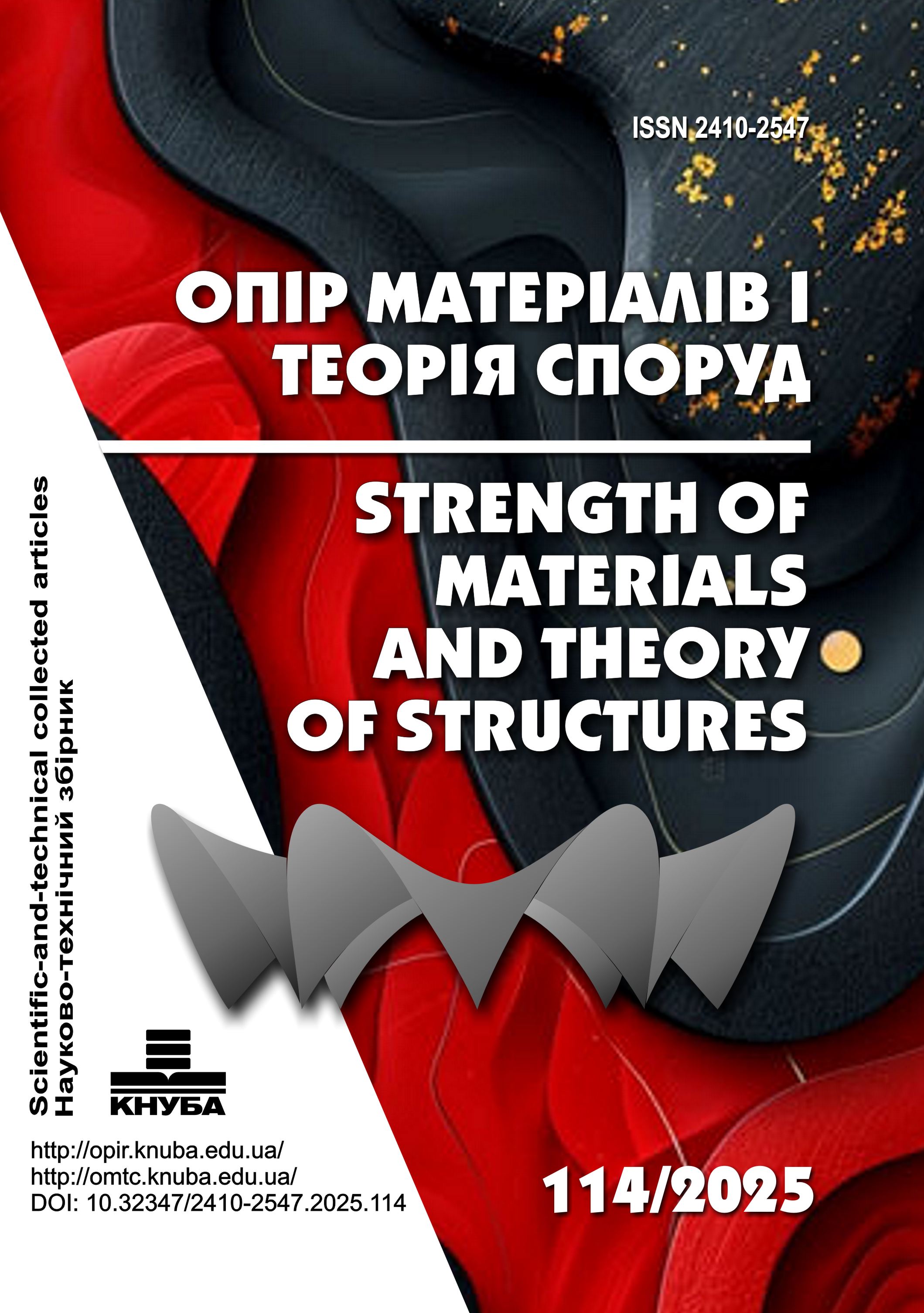Damage kinetics of anisotropic materials in construction
DOI:
https://doi.org/10.32347/2410-2547.2025.114.94-100Keywords:
kinetics of scattered damage accumulation, anisotropy of mechanical properties, representative element, effective stressAbstract
Anisotropic materials are widely used in modern construction and are subjected to various types of elastoplastic loads. Assessing their service life remains a relevant and pressing challenge. The study of damage kinetics in anisotropic materials holds both theoretical and practical significance, particularly in the field of residual strength assessment ‑ one of the leading research directions. The technical and economic efficiency of damage accumulation modeling under external force factors depends on the accuracy of predicting the material's damage evolution while maintaining strength and rigidity during operation.
This paper investigates the kinetics of damage accumulation in anisotropic materials under loading conditions, taking into account changes in the volume and shape of a unit-size representative element (RE), as well as the material’s physical and mechanical properties. Generalized Hooke’s laws, aligned with the symmetry axes of orthotropic materials, are analyzed, including cases where stress planes coincide or do not coincide with these symmetry axes. Theoretical and experimental studies of damage kinetics are carried out using polyvinyl chloride (PVC) samples employed in window and door profiles for residential buildings.
Over time, the operation of structures made of anisotropic materials leads to structural changes that initiate, propagate, and accumulate micro-damages of various origins and forms. These are driven by physical and chemical fluctuations within the material, such as the rupture of intermolecular bonds and breakdowns at the matrix-filler interface, resulting in the formation of macroscopic damage and ultimately leading to crack formation and structural failure. The emergence of such micro-damages degrades the material's physical and mechanical properties—namely, elastic moduli and Poisson’s ratios—ultimately altering the test volume of the RE in planes that are not aligned with the material’s symmetry axes and modifying its shape by introducing additional angular distortions.
The research shows that, in anisotropic materials, normal stresses in arbitrary directions lead not only to longitudinal but also angular damage. Shear stresses can cause both angular and longitudinal damage. Hence, the absence of angular change between two mutually perpendicular planes does not imply the absence of damage, as deformation still occurs on these planes. In general, the direction of damage-induced volume change in anisotropic materials does not align with the direction of principal stresses. The axes of the damage ellipsoid coincide with those of the stress ellipsoid only when the principal stresses act along the axes of elastic symmetry. In all other orientations, the damage and stress ellipsoids are not coaxial.
References
Troshchenko V.T., Krasovskiy A.Ya., Pokrovskiy V.V., Sosnovskiy L.A., Strizhallo V.A. Soprotivlenie materialov deformirovaniyu i razrusheniyu: Spravochnoe posobie, V 2-kh ch. (Resistance of Materials to Deformation and Fracture: In 2 Volumes. Reference Manual.). Kyiv: Naukova Dumka, 1993. Vol. 1. 288 p.
Grabovskyi A., Bondarets O., Babiienko I. Poshkodzhuvanist materialiv pry proportsiinomu navantazhenni (Damage of materials under proportional loading). Mechanics and Advanced Technologies, 2023, vol. 7, no. 2 (98), pp. 223–227. https://doi.org/10.20535/2521-1943.2023.7.2.261955.
Grabovskyi A., Bondarets O., Babiienko I. Kinetyka poshkodzhuvanosti materialiv pry riznykh rezhymakh povtorno-zminnykh navantazhen (Kinetics of damage of materials under various regimes of variable loading). Mechanics and Advanced Technologies, 2021, vol. 5, no. 3, pp. 325–331. https://doi.org/10.20535/2521-1943.2021.5.3.248026
Volkov I.A., Korotkikh Yu.G. Uravneniya sostoyaniya vyazkouprugoplasticheskikh sred s povrezhdeniyami (Constitutive equations of viscoelastoplastic media with damage). Moscow: Fizmatlit, 2008. 424 p. ISBN 978-5-9221-0965-9
Lemaitre J., Desmorat R., Sauzay M. Anisotropic damage law of evolution. European Journal of Mechanics - A/Solids, 2000, vol. 19, no. 2, pp. 187–208. https://doi.org/10.1016/s0997-7538(00)00161-3
Bobyr M.I., Bondarets O.A. Phenomenological model of scattered fracture for anisotropic materials. Strength of Materials, 2023, vol. 55, pp. 945–953. https://doi.org/10.1007/s11223-023-00585-6
Downloads
Published
Issue
Section
License

This work is licensed under a Creative Commons Attribution 4.0 International License.
Authors retain copyright and grant the journal right of first publication with the work simultaneously licensed under a Creative Commons Attribution License that allows others to share the work with an acknowledgement of the work's authorship and initial publication in this journal.

